|
|
Thoroughbred Horse Racing and Breeding in South Africa
 |
By Philip Herringer. ©2004. All Rights Reserved.
View a Map of South Africa
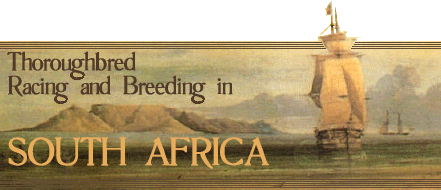 |
This condensed article about the history and nature of horse racing and breeding in South Africa is written particularly for interested people living on other continents. In the horse racing countries of the Southern hemisphere, namely the non-tropical Latin American countries of Argentina, Chile and Uruguay, Australia, New Zealand and South Africa, most racing and breeding takes place in Mediterranean, temperate and sub-tropical climates. Warm or hot sunny summer days and mostly mild winter days are typical, though inland the nights can be very cold. In nearly all places, there is no need to stable mares, foals and weaned rising yearlings, as predatory animals are now extremely rare or non-existent.
Racing is a year round affair, with meetings rarely cancelled because of rain. This contrasts with most racing centres in Europe and the northern and eastern United States and Canada, which are subject to severe winter conditions. South Africa is especially noted for its sunshine and mild weather. Little wonder, then, that racing is a popular pastime.
Earliest Days
Up until the mid seventeenth century, horses and donkeys were found only in North Africa and countries on the edge of the Sahara. Southern tribes were either nomadic, or lived in small settlements; they were not familiar with the wheel, and there were no beasts of burden. Horses in Southern Africa came with European settlement, after the Dutch occupied the Cape, now modern Cape Town, in 1652. Initially, ox-drawn wagons and carts were the means of heavy transport. The first Dutch governor, Jan van Riebeck, imported horses from the earlier Dutch settlement, Batavia (1619), in Java, for riding and drawing light carts . These were small Timor pony types which still have an influence in Southern Africa today, particularly in the tiny mountain kingdom of Lesotho which has given its tribal name to the Basuto pony. It was another forty years before some Persian stallions were imported to the Cape to improve the local breed of horse, and these were followed by stallion imports from South America, as well as some English thoroughbreds. But small size was to be the Cape horse's feature for the first one hundred and fifty years, until English throughbred stock was imported with increasing frequency.
|
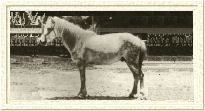
A Contemporary Timor Pony
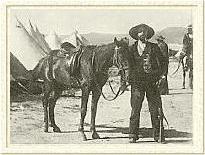
Capers were the first racehorses and also used as remounts, shown here during the Boer War

| |
The Cape Dutch had no interest in horse racing, and in the first one hundred and fifty years of settlement, horse breeding was confined to the small local market. After the British settlement of New South Wales in Australia in 1788, the Caper, as the local South African horse came to be known, provided the foundation stock for horse breeding there, and in the second half of the 18th century horses were exported to India for racing and as army remounts. Thanks to these markets, horses became the most valuable export from the Cape, and in the case of Australasia, had an important influence on the so-called Colonial families that comprise the early running horse heritage of that region. A few South African farmers specialised in breeding Capers, notably the van der Byl family at Eerste River outside Cape Town. This is not suitable horse breeding country, and might have been a contributing factor to the Caper's small size, a common complaint for many years to come.
When the Cape came under British rule in 1795, horse racing was soon established, and this led to the increasing importation of thoroughbred stallions and mares which infused the local stock with greater vigour. The Caper, by now carrying some degree of thoroughbred blood, did well in India, as racing reports of the time show. By the second decade of the nineteenth century, and continuing to the 1860s, the Caper was prominent on the turf there, but in the latter part of the century the racing and remount market was taken over by thoroughbreds and the Waler from Australia. Other markets for Cape horses after the Napoleonic wars were Mauritius and the tiny garrison island of Saint Helena.
In South Africa, as the 19th century progressed, there were many favourable reports from reputable English horsemen, mainly in the military, which spoke in glowing terms of the sturdiness and hardiness of the Caper. In the wars against the indigenous tribes, and then in the British wars against the South African Dutch, the Caper performed well as an army remount.
|
The Beginning of Racing
This came with the first British occupation of the Cape ( 1795 - 1803) and then the permanent occupation, which began in 1806. These seizures were to prevent the Cape from falling into French hands in the Napoleonic years.
The first garrison races were held in 1795 at Green Point, a couple of miles from the town's center. The horses were local Capers and some imported horses belonging to officers. Jockeys were local people of Hottentot and mixed racial origin, along with some British officers. But these were amateur affairs, run mainly for the garrison's entertainment. There was a racing hiatus when the British left in 1803, and it did not begin again until 1810, after they had returned. Horse racing received a substantial boost after the colony's new governor, Lord Charles Somerset, a younger son of the Duke of Beaufort, arrived in 1814. He organized a government stud, importing quite a large number of thoroughbred English stallions and mares, and encouraged other wealthy inhabitants to import racing bloodstock, with a consequent increase in the number and geographic spread of race meetings.
|
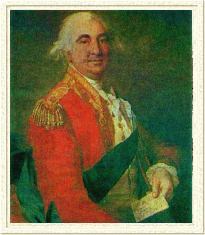 Charles Somerset
Charles Somerset
| |
Although initially racing was essentially a Cape Town entertainment, with a few meetings taking place in some of the bigger country towns, by 1825 there was racing in ten colony venues, boosted by the influx of 4,000 British Settlers in 1820, many of whom abandoned their Eastern frontier farms in favor of a more comfortable life in Cape Town, or in the growing city of Port Elizabeth and other newly-settled and growing towns. Growth in racing took place as a result of British settlement in the Eastern Cape with Port Elizabeth as its commercial centre, and the Natal Colony around Durban.
In the Port Elizabeth area some racing had taken place before the 1850s, but it was irregular until the Port Elizabeth Turf Club was formed in 1857, and in the 1860s, while racing declined in Cape Town, it increased in Port Elizabeth, which had an English cultural base and was experiencing economic growth, largely due to a developing wool-producing industry. Inland, by the 1830s there was racing Cradock Turf Club.
|
Racing in Natal began in the 1840s. The first meeting of the Pietermaritzburg Turf Club , in the capital, took place in 1844, and Durban's first meeting was in 1851. In 1864, the Jockey Club of Natal was formed as a body to regulate racing and make rules. Racing was an annual event for the clubs, the "season" lasting several days. As in Cape Town and the Eastern Cape, horses were bred locally, and only a few were purebred.
During this period, breeders were producing racehorses by crossing thoroughbred stallions on Caper mares, or half-bred mares. This led to improved runners, as witnessed locally and by their performances in India, at least until mid-century. Until the late nineteenth century, most stud farms were located within 100 miles of Cape Town, dominated by the Van der Byls, the Van Bredas, the Melcks, and a Mr. Kirsten. Around mid-century, improvement in race horse breeding began to falter, due to the limited number of thoroughbred stock, poor stud management and location, and the devastation of African Horse Sickness. Export markets fell, particularly in India, as the Australian Walers and imported thoroughbreds began to supplant the earlier imported Caper stock.
However, the stuttering bloodstock breeding industry in South Africa in the latter quarter of the nineteenth century was the recipient of two benifices, both side-effects of economic development unrelated to horses. First, starting in the 1830s, South Africa became a colonial supplier of wool for the English and world mills of the Industrial Revolution. The dry, semi-desert inland area called The Karoo, and the savannah areas inland from the Eastern and Central Cape coast were found to be suitable for raising sheep, particularly Merino sheep that seemed to thrive there. Farmers noticed that horses raised on these farms developed particularly good bone and constitution. Unrecognized at the first, the soils of The Karoo had a perfect ratio of protein, calcium and phosphorous for horse breeding, and in time a roughly triangular area within The Karoo, defined by the towns of Colesberg, Middelburg and Cradock, developed into a premier area for breeding and raising horses.
Second, was, of course, the discovery of South Africa's rich diamond fields, followed soon thereafter by the discovery of gold.
Racing Follows New Wealth
In 1871, the Kimberley, the richest diamond field the world had seen was discovered about 100 miles northwest from Colesberg. Two years later the first South African gold fields were discovered, 400 miles to the northeast, in Pilgrim's Rest. These new riches brought a rush of miners and their followers from Europe and Australia. The newcomers brought a frontier life style of hard work and hard play. Being the nearest established coastal commercial center, Port Elizabeth grew in importance, eventually, in 1885, linked by rail and stage coach to the Kimberley, which had the same transit link to Cape Town. A year later, in 1886, even more stupendous mineral wealth was found on the Witwatersrand (the ridge of White Waters), the world's richest goldfields. The latter brought a huge influx of seekers from the diamond fields and earlier gold fields in-country, and even more from all over the world, particularly Europe, Australia and North America. This rapid increase in population led to the establishment of a new township, Johannesburg. Those who made their fortunes in The Rand, and stayed in South Africa to spend their wealth, became popularly known as "Randlords."
The millionaires from the Kimberley diamond fields made further fortunes out of gold, and, along with the other accoutrements of wealth, became keen supporters of racing. Moving easily between hemispheres, supported by enormous fortunes, they made connections with the best the world's racing had to offer, and ran the expensive animals they purchased in England, France and South Africa, with huge success. Many became thoroughbred breeders, who could well afford to spend more on top quality imported stock, both for breeding and racing. Professional racing men, both trainers and jockeys, arrived from Europe and Australia to participate in a reinvigorated racing industry, in which a rapid succession of institutions and racecourses were established.
|
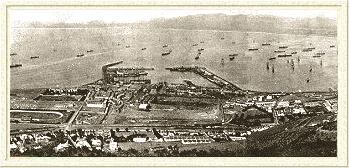
| | Cape Town during the Boer War, c. 1900; the race course can be seen to the left.
|
The Jockey Club of South Africa was formed in Port Elizabeth in 1882, establishing set rules for racing. Founding members included three influential thoroughbred breeders from the Karoo "triangle" -- Charles Southey, Alex Robertson, and Hilton Barber, all of whom had established studs in the wake of the wool boom in the 1870s. A South African stud book was established, limiting eligibility to horses that could be traced in official world stud books; its first volume was published in 1906.
Charles Southey was the son of Sir Richard Southey, a pioneer 1820 Settler who bred sheep in The Karoo. Southey's stud, Culmstock, located near Middelburg, dominated thoroughbred breeding in South Africa for thirty years, initially with the imported stallion Whack'um (by Morgador), and then the multiple champion sire Pearl Diver (by Master Kildare). The latter won eight races in England, including an 1885 Stewards' Cup, and then became a winning show stallion there, until he was purchased in 1891 and sent to stud in South Africa in 1894. Southey, who died at the age of 93 in 1925, was one of the first breeders to import high-class thoroughbred mares. and when bred to Pearl Diver, they produced such South African Derby winners as Valhalla, Vasco, Verdant Green, Green Sea, Wild Plunger, Ocean Gem, Peerless, and Camp Fire II. He also bred the only two South African horses to win in England up until the mid-1920s, Pearl Rover and Camp Fire II. The Southey sheep farms still have a great impact on South African wool, and Southey descendants are still breeding thoroughbreds.
|
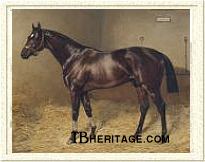
Pearl Diver, a winning sprinter in England, led the sire's list in six successive years.
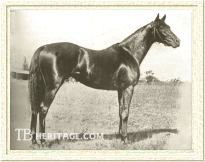
Colesberg, bred at Stormfontein, was South Africa's first "Triple Crown" winner; his sire and damsire were both imported.
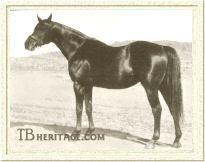
Kerasos, by the short-lived Kennymore, the only son of John o' Gaunt's besides Swynford that was any good on the turf, was imported by Allan Robertson in the 1920s and posthumously became champion sire in 1935.
| |
Hilton Barber, who farmed near Cradock, bred and owned the first South African Derby winner in 1885, and the next five but one.
A Scot by birth, Alex Robertson was a trainer, owner and breeder who married into an old Cape family. Five early South African Derby winners -- Irene, Lammas, Diana, Blanche and Colesberg -- were bred by Robertson, whose stud, Stormfontein, was located near Colesberg. He also bred a top South African sprinter, Abelard, and co-owned the 1895 South African Derby winner Rosary. He imported the stallion Uniform, from New Zealand, who sired Derby winner Diana, and then, in 1911, the unraced St. Simon son, Simontault, who had been injured as a yearling, in 1911, but the stallion died early, in 1916, although not before he had gotten Blanche and some other good runners for Stormfontein.
Colesberg (1917), who was by the imported British horse Wilfred, and out of a Uniform daughter, was sold by Robertson as a yearling for 150 guineas; in addition to winning the Derby, he won the Guineas and the St. Leger at Benoni, becoming South Africa's first "triple crown" winner.
Robertson's son, Allan, continued from his father and became an authority in racehorse breeding and administration. During the Boer War (1899-1902), the then ten year old Allan and his mother managed the stud whilst Alex was away on active service, and were forced to watch a Boer commando unit appropriate four stallions and thirty mares, all of which were returned the following day by a Boer general who had been informed that some of the horses belonged to wealthy Randlord Abe Bailey.
Stormfontein-bred horses ran successfully well into the 20th Century. Stormfontein's principal stallion in the late '20s and early '30s, Kerasos (by Kennymore, a John o' Gaunt son), was champion sire in 1935.
After World War II, Robertson imported the well-bred Mehrali (Mahmoud - Una, and a half-brother to Palestine), who was the grandsire of Hawaii. He also imported the highly successful Abadan, who stood for one season in Ireland before coming to South Africa. His crop there included the Irish 2000 Guineas winner Jack Ketch (later a sire in Australia) and My Pal, later a good sire in New Zealand. In South Africa, Abadan was leading sire in 1960; he was later repatriated to England.
|
In the last decade of the 19th Century, racing became concentrated in the main cities, though several smaller country courses survived into the 1920s. Almost within a year of the discovery of gold in Johannesburg, a racecourse with a stand was in operation when the Johannesburg Turf Club held its first meeting in June 1887. The first South African Derby was held at Port Elizabeth in 1885, and run annually there until the turn of the century, when it was moved to Johannesburg, which had become the racing centre of South Africa, well-supported by the wealth that had spilled from The Rand.
Of the Randlords who became involved in racing, there were many whose wealth provided them an entree into the highest social circles of Edwardian England, and also supported their great success in British racing circles, and several established important studs in England that were influential well into the 20th Century. These included S.B.(Solly) Joel, his brother J.B. (Jack) and their relatives. Solly, Jack, and a third brother, Woolf (murdered in 1898) were the nephews of Barney Barnato, who, with Cecil Rhodes, at one time controlled all diamond production in Kimberley. The Joels inherited the business from their uncle, Harry, in 1908; Harry had succeeded the reportedly depressed Barney, who, enroute to England on the mailship, jumped overboard and drowned in 1897. Both Barney and Harry ran horses in England, late in life: Barney's Worcester won the City and Suburban in 1896, and Harry's Sir Geoffrey won the Lincolnshire Handicap of 1900.
J.B., charged with illicit diamond buying, jumped bail in South Africa and headed for England. He became the most successful breeder in England in the first two decades of the 20th Century. His Childwick Bury Stud, turned out winners of eleven classic races between 1900 and 1918, including the champion fillies Jest and Princess Dorrie, and the Derby winners Humorist and Sunstar. He also bred Absurd, who later was sent to New Zealand, where he became an extremely influential sire, and Your Majesty, a good sire in Argentina. The great sprinter Sundridge, purchased by Joel as a horse in training, became the principal stallion at Childwick Bury; he was the grandsire of imported Sunstone, a multiple champion sire in South Africa.
Solly Joel was also successful on the English turf, although his racing stables, first at Sefton Lodge, and then Moulton Paddocks, turned out only one classic winner, substitute (wartime) Derby and St. Leger winner Pommern. He had a number of other good winners in horses such as Ascot Gold Cup winner Bachelor's Button, Doncaster Cup winner Long Set, and other top runners. Solly purchased Polymelus as a horse in training, and later sent the horse to his Maiden Erlegh stud near Reading, where he became a highly influential sire. Solly also had major interests in racing in France, and in his native South Africa. His son, Stanhope, owned the 1967 champion in England, Busted.
|
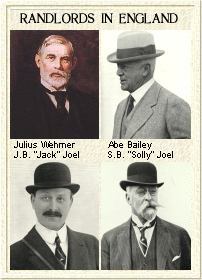 The Rand's riches were the financial underpinning for some of England's most influential breeders in the first decades of the 20th century. Bailey and the Joels also had extensive racing and breeding interests in South Africa.
The Rand's riches were the financial underpinning for some of England's most influential breeders in the first decades of the 20th century. Bailey and the Joels also had extensive racing and breeding interests in South Africa.
| |
Other racing Randlords were Sir George Farrar, and Sir David Harris who was Barney Barnato's cousin, Sir Julius Wernher and Sir Lionel Phillips.
Of these, Sir Julius Wernher, a founder of the gold and diamond empire now known as De Beers, became prominent in England's Edwardian society, with a mansion in Piccadilly and the lavish Bedfordshire estate, Luton Hoo, which was entirely remodeled just after the turn of the century in the Louis XVI style.
Wernher was born in Germany and, in 1880, was sent to South Africa by French diamond merchant turned South African mining magnate, Jules Porges, where he was wildly successful. Wernher settled in London in the late '80s, which served as a base for running his large South African mining house.
His son, Sir Harold Wernher, and daughter-in-law, Lady Zia Wernher, had a successful racing stable at Newmarket, from which the great staying gelding Brown Jack won his many races, and their Someries Stud in England and their County Kildare Blackhall Stud produced such horses as Precipitation, the dual-classic winning filly Meld, and Meld's son, Derby and St. Leger winner Charlottown.
|
But the best-known Randlord was Sir Abe Bailey (1864 - 1940) who was born in Hilton Barber's town of Cradock, where his father was a store keeper. He started his business life as a young man on the alluvial diggings at Pilgrims Rest, then at Barberton in the Transvaal. In the newly-founded Johannesburg he operated as a stock and land broker. He later told the story that he made £400 in one day, which gave him his start -- £300 were from a benefactor for his performance in a cricket game, and then another hundred that night for riding a horse at the visiting circus! Abe was a member of the Reform Committee which planned the failed Jamieson Raid in 1896, a revolt by the Uitlanders -- as "outsiders" were called -- against the government of Paul Kruger. Under threat of a death sentence or long prison term, bribes bought his freedom, and that of others. In the first World War, Abe financed a South African regiment, and for this he was rewarded with a knighthood and baronetcy.
From the 1890s to the 1930s, Bailey and Solly Joel were very successful owners in South Africa. Both had Durban July winners. Bailey sent his Southey-bred horse Camp Fire, by Pearl Diver, to England where he was the champion sprinter in 1907 winning six races including the Kings Stand Stakes at Royal Ascot. Camp Fire got some useful horses in three seasons at stud at Tickford Park in England before he was purchased back to South Africa by Dr. Schnehage, a breeder in the Orange Free State. Amongst many good horses raced by Sir Abe in England were the Derby winner Spion Kop and the great sire of stayers, Son-in-Law.
Bailey founded the successful Clewer Stud in Colesberg. Dark Ronald, who was to become an influential sire in England and Germany, was purchased by Bailey as a yearling in England. He was sent to Clewer to recuperate after breaking down as a juvenile in his second English race. The best sire at Clewer was the multiple champion stallion in the 20th Century, Sunstone (by Sunstar), imported in 1927, who later stood at the Birch Vogelvlei stud at Dordrecht. Another imported stallion at Clewer, one-time champion sire Pietri (by St. Frusquin), became an influential sire of broodmares. Sir Abe died in 1940, his last years hampered by the loss of his legs through diabetic thrombosis. But he never lost his interest in horse racing and breeding, and his grandson still breeds winners at Clewer.
Consolidation and Importation
Racing in the first half of the 20th Century was characterized by increased regulation by the South African Jockey Club, a reduction in the number of racing venues and an improvement of facilities at major population centers. First and second generation Randlord wealth dominated South African breeding, as virtually all principal stallions -- and many mares -- during these years were imported, largely purchased from gold and diamond-based riches. This same wealth also purchased and imported racehorses that prevailed in South Africa's richest races, and had the unfortunate effect of retarding the development of a strong local bloodstock industry.
|
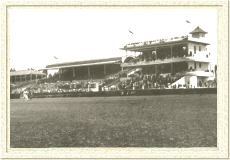 Johannesburg race course in the 1920s.
Johannesburg race course in the 1920s.
| |
Although there were never many non-white jockeys and trainers participating in South African racing, in the 1920s the South African Jockey Club officially introduced regulations banning the participation of non-whites in racing (except as grooms), anticipating the government's Apartheid policies by some twenty-plus years. All professionals -- jockeys and trainers -- and owners were required to register with the Jockey Club. Many of the various racing clubs that had been established in the 1880s were still extant, and their members served as honorary stewards at meets, but all racing matters were firmly in control of the Jockey Club.
|
Smaller country towns continued to feature weekly meetings, but by the 1930s racing was limited to the larger population centres of Johannesburg, Cape Town, Port Elizabeth, Pietermaritzburg, Bloemfontein, Kimberley and East London. By the 1950s, racing in the latter two locations had ceased, although racing was revived in Kimberley in the 1990s, and Bloemfontein continues to feature weekly meetings.
Johannesburg was the principal site of racing, with mid-week as well as Saturday and holiday meetings. Every quarter there was a feature race carnival with the biggest event being the Johannesburg Summer Handicap (known as the Christmas Handicap), now the Summer Handicap Cup. These days, Johannesburg has two racecourses, at Turffontein and at Newmarket, and another course is located forty miles distant, at the Vaal. The coastal cities of Cape Town and Durban had their main carnivals in their dry seasons, which are the summer in the Cape and winter in Natal. The biggest races are now the Cape Metropolitan Stakes (formerly the Cape Metropolitan Handicap), the Cape Guineas, and the Cape Derby; the Durban July Handicap, and the Durban Gold Cup. Today, Cape Town has two race courses, Kenilworth, with two tracks, and Durbanville, outside the city.
Tropical Durban's racing was organized around the dry mid-year, with the institution of the rich Durban July Handicap in 1897, still the country's premier racing event that draws holiday crowds from all over the country. Today Durban has two courses, at Greyville, in the city, and at Clairwood on the outskirts, and a world-class training track with on-site stabling for 1,000 horses and the South African Jockeys' Academy is located at Summerveld, in the hills outside of Durban. Port Elizabeth also features two racecourses, Fairview and Arlington, and Kimberley and Bloemfontein each have a racecourse.
While South Africa featured juvenile racing and instituted some classic races for three year olds in the first decade of the 20th century, the biggest purses were reserved for the principal handicap races. Many owners imported moderate runners from Great Britain, Australia, Argentina, and elsewhere, that were able to beat locally-bred horses in the big handicaps. Good locals were given extra weight imposts for past wins, whilst untried imports had a weight advantage until they showed form. In addition, most racing imports contributed virtually nothing of value to South African bloodstock when retired to stud, and further depressed the breeding industry by lowering the price of South African-bred horses. In the first fifty years of the important Durban July Handicap, less than a third of the winners were South African-bred. In an attempt to remedy the situation, a ban on imports for racing was imposed by the government in 1950. Stallions and mares for stud purposes only could be imported with a limit on the total amount spent annually.
The Jockey Club published the first volume of the General Stud Book of South Africa in 1906. Reaching back into the imperfect record keeping of the past, the stud book recorded 382 mares, of which 185, or almost half, were imported from Great Britain, 28 from South America, and 10 from Australasia, the remainder bred in South Africa whose antecedents had been imported, mostly within two generations. Of the 98 registered stallions, 77 had been imported from Great Britain, nine from New Zealand or Australia, and five from North or South America, two less than the seven born in South Africa.
The bulk of the animals recorded in the first stud book were owned by the early breeders noted earlier, such as Charles Southey, Hilton Barber, and Alex Robertson, and Sir Abe Bailey. One of the characteristics of South African breeding during the entire period, up through the middle of the 20th century, was the extremely high proportion of stallions to mares; in 1906 there were three mares to every one stallion registered, and as late as 1952, there were seven registered mares to every stallion. This was due to the great distances between studs, and to inadequate means of transporting stock between them. Breeders tended to limit their mares to to their own farms' stallions, which in part accounts for the large blocks of years dominated by single stallions in the leading sires list, and which had the undesirable subsidiary effect of ultimately limiting out-crossing.
|
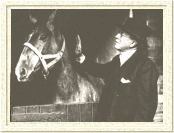
Henry Nourse
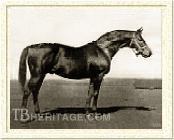
Greatorex, leading sire for ten years.
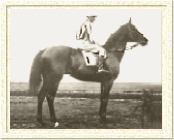
Polystome, leading sire eleven times. Both stallions were owned by Henry Nourse.
| |
One breeder who fell into this trap was Henry Nourse, who fought in the Zulu Wars of the 1870s as a local military officer, and then made a fortune in gold mining. A race horse owner long before the Boer War, he had big strings of racehorses in training, many of which won the principal races. By the turn of the century he had established his Dwarsvlei Stud, near Middelburg, one of several he was to own simultaneously within The Karoo triangle, from which he bred hundreds of winners from imported stallions, for which he paid large prices. He dominated the leading breeders lists for the first forty years of the century, the sheer number of products of his huge operation dominating South African races.
Nourse had huge success with the crosses of Pearl Diver (by Master Kildare), Greatorex (by Carbine - Mrs Butterwick) and Polystome (by Polymelus) bloodlines. These stallions were the champion sires for most of the years 1890 to 1940, with Greatorex leading the list ten times after the turn of the century. Greatorex (1900) had been a good juvenile in England, but broke down training for the Epsom Derby, and was purchased by Nourse as a sire for Dwarsvlei; his son, Dignitary (1918), won the South African Derby and St. Leger and thirteen other races, and later (1934) was a champion sire, the first South-African bred stallion to make the list. Dignitary was out of the great racemare Dignity, by Minor Forfeit (1894, by Minting). Minor Forfeit was a horse that ran once in England at age two, and then was imported into South Africa by Nourse, for whom he won eight races before retiring to stud at Dwarsvlei, where he was champion sire once, in 1915.
Polystome (1912, by Solly Joel's Polymelus, out of a Bread Knife mare), was a Joel import, who won two juvenile races and one three year old race in England before his purchase, and went on to win five races in South Africa before being purchased at age seven by Nourse, and retired to stud. He led the sire's list between 1924 and 1933, and was champion sire again in 1938. Fortunately for Nourse, he crossed well on Greatorex mares. On Nourse's death in 1940, his estate had over 1,000 horses including 400 mares. His breeding activities were based on leasing all racing progeny, with the fillies and mares returned to his studs. This was not always in the best interests of breeding from the best stock, and led to a weakening of the stud's bloodlines.
|
As Dwarsvlei stud's influence waned, another farm was rising in prominence and was to largely dominate South African breeding between 1940 and the 1980s. This was the Vogelvlei Stud of E.V. Birch, located at Dordrecht. Dordrecht lies at an altitude of 6,000 feet in grassland country on the slopes of the Drakensberg range, South Africa's equivalent of the United States' 'Great Divide.' In winter, days are cool with freezing nights and regular snow falls. Vogelvlei lies in a valley of many thousands of acres. Mares and foals run in huge paddocks of natural and planted grasses on which sheep also graze.
Birch came to South Africa from Yorkshire as a young man and married the daughter of a district pioneer. He initially bred draught horses, but after World War I shifted to breeding thoroughbreds. He went to England, where he purchased a few stallions and about thirty mares. His stud had moderate success with the White Eagle son, Bird of Prey, and then the Buchan son, Cockpen, a brilliant two year old in England that Birch imported in 1933 who became a good sire in the late '30s and early 40s, placing second on the sire's list to Sunstone in 1942. But it wasn't until Sir Abe Bailey, scaling down his breeding stud in the last years before his death in 1940, passed on some valuable breeding stock to his friend, Birch, that Vogelvlei rose to its dominant position.
Among the horses Birch acquired from Bailey was imported Sunstone, already twice leading sire for Bailey's Clewer Stud. Beginning in 1940, Sunstone became leading sire again, for three successive years, all posthumously, since his last crop were foals of 1939. One of these foals was Lenin, out of the imported mare Drohsky, who was sold as a yearling to M. Lipschitz; Lenin was generally held to be the best racehorse produced in South Africa to 1944, the year he retired from the turf, the winner of 18 races, placing second six times, in a five year career that netted him winnings of £15,943, a record to that time. In the late 1930s E.V. Birch handed over the running of the Vogelvlei enterprise to his four sons, three of whom -- Syd, Vivian, and Walter -- fought in World War II; Vivian, a sergeant, died in a POW hospital and was buried in Naples, Italy. The fourth son, Edward (Ted), managed the stud with his father while the others were away.
|
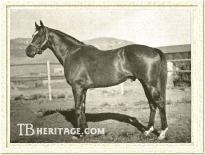 Vogelvlei Stud's Fairthorn led the sire's list five times; his best running son was Sea Cottage
Vogelvlei Stud's Fairthorn led the sire's list five times; his best running son was Sea Cottage
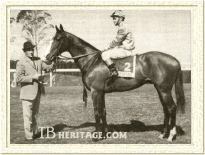 Vogelvlei's Sea Cottage had great speed and class, winning a record R117,037-1/2, including the Cape Derby and most of the principal handicaps
Vogelvlei's Sea Cottage had great speed and class, winning a record R117,037-1/2, including the Cape Derby and most of the principal handicaps
| |
In 1939 the very well-performed French-bred Asbestos II (1932), by Asterus, was purchased from the great Cape Town trainer Syd Garrett, who had purchased him from Lord Derby. Asbestos had won the Cape Metropolitan Handicap in 1937, and had placed second in the Durban July. At Vogelvlei he was an immediate stud success and from 1945 he was champion sire for six successive years, though unfortunately he died prematurely in 1944. His blood through female lines continued in many Birch-bred champions, such as Sea Cottage, Colorado King, and Wolf Power, the latter two at stud in the United States.
After World War II, three Birch sons -- Sydney, Ted and Walter -- each assumed control of a separate farm, all of which operated under the Vogelvlei Stud name, with a total of about 120 mares. They imported a succession of high-class stallions that became champion sires: Fairthorn (by Fair Trial), Ranjit (by Fairway), Herculaneum (by Donatello), High Veldt (by Hyperion), New South Wales (by Abernant), and Plum Bold (by Bold Ruler). In addition, South African-bred Elevation (1968), by their champion sire High Veldt, won the South African Derby in 1972, and became Vogelvlei's champion sire in 1984, the only South African-bred horse besides the Greatorex son, Dignitary (1918), ever to occupy that position.
Another stallion at Vogelvlei was Merchant Navy (by Hyperion - Rose of England), who was a good broodmare sire, and was damsire of the great racehorse Sea Cottage (1962, by Fairthorn), bred by the Birch brothers; Sea Cottage's female line was strict Vogelvlei breeding for several generations, going back to Drohsky, the dam of the 1944 champion racehorse, Lenin. Other good sires at Vogelvlei included Djask (Tourbillon - Loika), Turbulent ( by Indus), Olina (by Solario) and Grand Rapids (by Macherio), the latter also a distinguished broodmare sire.
|
Shutting Out Imports, Sending Out Winners
As a result of import difficulties during the Second World War , and pressure from local breeders after it, in 1950 the government placed a ban on horses imported for racing purposes. There was also, for economic reasons, a limit on the amount that could be spent annually on imported breeding stock. This policy continued until the early 1970s when imported yearlings, in particular fillies, could be imported for racing prior to going to stud. These came from Australia, New Zealand and the Argentine, where horses were bred to the Southern hemisphere season. They were later allowed to compete in the local classics, and later still, the restriction on imported mares and stallions for racing was lifted, provided that they were imported for eventual stud purposes. No geldings were, or are permitted to be imported. After the relaxation of import regulations, a number of mares and fillies from Australia, New Zealand, Argentina and the Northern Hemisphere were brought into the country, broadening the bloodline base in the distaff population.
1954 saw the last imported feature race winner when Coquimbo (by Montrose) won the two mile Durban Gold Cup. For the next twenty years, no overseas-bred horse won a major race until 1975 when New Zealand-bred Sledgehammer, imported as a yearling, won the ten furlong Cape Metropolitan. Since the 1950s, South African-bred horses have won almost all stakes races.
Beginning in the 1970s handicap stakes races were replaced by either weight-for-age races, or a handicap system based on age, earnings and performance over the distance. Now, as in other countries, the greatest percentage of races are of sprint distances up to a mile. The major stakes races are ten furlongs, with very few races of staying distances. The Gold Cup in Durban over 2 miles is the richest of the latter.
|
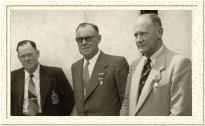
The Birch brothers of the famous Vogelvlei Stud, Ted, Syd and Walter.
| |
The wool boom of the 1950s brought many sheep farmers into horse breeding, some of whom stocked their stud farms with huge dispersal of Nourse's Dwarsvlei Stud. In the '80s, the Birch breeding empire, then in its fourth generation, began to scale back. Towards the latter part of the century, South African breeding reflected world-wide trends, with newcomers whose main source of income was in industry, not farming.
|
The latter decades of the 20th century saw the rise of large breeding syndicates, represented by such horses as six-time leading sire Persian Wonder (by Persian Gulf) and five-time leading sire Jungle Cove (by Bold Ruler), both at the successful Highlands Stud, and Foveros (by Averof), an eight-time leading sire who stood at the Scott Brothers Stud.
Other recent breeding enterprises with champion stallions include Paul de Wet's Zandvliet Stud ( Noble Chieftain by Nearco - three times leading sire ) , the Oppenheimers Mauritzfontein Stud ( Wilwyn by Pink Flower and Fort Wood by Sadler's Wells ) and Granville Gorton's Noreen Stud ( Drum Beat by Fair Trial). Starting in the late '70s, breeders began to look towards North America for stallions: Vogelvlei's Bold Ruler son, Plum Bold, was a successful sire, leading the list in 1980 (he was repatriated to the States), and Highlands Stud's Jungle Cove, another Bold Ruler son dominated the list in the first half of the '80s. Since then, six other stallions imported from the U.S. have risen to the top of the stallion ranks.
Starting in the '60s, South African-bred horses began to attract international attention. Birch Brothers-bred Colorado King (1959, by Grand Rapids), a phenomenal and wildly popular three year old in South Africa, was sold to the U.S. soon after winning the rich Durban July Handicap. He won several races there, including the Hollywood Gold Cup in world record time.
|

Hawaii, a champion runner in South Africa, set a track record on the turf at Belmont in the U.S.; he later sired an Epsom Derby winner
| |
Hawaii (1964, by Utrillo) was bred by A.L. Dell at his Platberg Stud in Colesberg, where the Italian-bred Utrillo stood; his dam, Ethane, was a second generation South African-bred mare and an excellent producer of eleven winners of over 50 races. Purchased by New Jersey millionaire Charles Engelhard when a yearling for $12,642, Hawaii 's wins of fifteen races in South Africa made him the country's champion racehorse, after which, in late 1968, Engelhard sent him to the U.S. to run , where he won six good races (five on the turf), including the the United Nations and Sunrise handicaps at Atlantic City, and the Man o' War handicap at Belmont, where he set a new track record for 1-1/2 miles. He did not return to South Africa, instead syndicated for 1.12 million dollars and sent to Claiborne Farm, Kentucky, to stand at stud; one of his sons, Henbit, won the 1980 Epsom Derby.
|
Other South African exports, all champions before being sent to the U.S. to run, included Bold Tropic (by Plum Bold), Prince Florimund (by Dowdstown Charley), Wolf Power (by Flirting Around), Horse Chestnut (by Fort Wood), and, very recently Ipi Tombe. Other South African-bred horses have been winners in Dubai, Singapore and Hong Kong, against world class competitors.
Bibliography
Jaffee, J : They Raced to Win 1797 - 1979. A History of Racing in South Africa. C. Struik, Cape Town 1980.
Wyndham, The Hon. H.A. : The Early History of the Thoroughbred Horse in South Africa. Oxford University Press, 1924.
Cole, Monica: South Africa.Methuen, London, 1961
|
|

